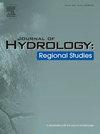Patterns of blue and green water in the Yellow River Basin from 1998 to 2020: Influence of climate change and human activity
IF 4.7
2区 地球科学
Q1 WATER RESOURCES
引用次数: 0
Abstract
Study region
The Yellow River Basin in China.
Study focus
The hydrological cycle in the Yellow River Basin is undergoing significant changes due to the combined effects of climate change and human activities. Based the simulations of a processed model and observational data collected from official bulletins, this study focused on investigating the spatiotemporal variations of blue and green water in Yellow River basin from 1998 to 2020. Furthermore, the Partial Least Squares Structural Equation Modeling (PLS-SEM) method is used to quantify the respective contributions of climate change and human activities to these observed patterns.
New hydrological insights for the region
During the study period, both blue water volume and green water flow increased overall across the Basin where blue water volume and green water flow were higher in the west than in the east. Water withdrawal (including water consumption and water return flow) showed an increasing trend that mainly concentrated in the Toudaoguai (TDG) area, mainly due to increases in domestic and ecological water consumption, since water return flow showed a decreasing trend (due to decreases in agricultural and industrial water return flow). Climate change affected blue water volume and green water flows mainly through changes of precipitation (the path coefficient β > 0.59). Changes in land cover were able to explain 87 % of the observed variation in water return flow and 95 % of the observed variation in water consumption and subsequently affected green water directly through water consumption (β = 0.515). Changes in land cover indirectly explained 20.9 % and 27.3 % of the variations in blue water volume and green water flow, respectively. Climate change showed greater influences on blue water volume and green water than human activities. These findings highlight the need for efficient water management in the Yellow River Basin.
求助全文
约1分钟内获得全文
求助全文
来源期刊

Journal of Hydrology-Regional Studies
Earth and Planetary Sciences-Earth and Planetary Sciences (miscellaneous)
CiteScore
6.70
自引率
8.50%
发文量
284
审稿时长
60 days
期刊介绍:
Journal of Hydrology: Regional Studies publishes original research papers enhancing the science of hydrology and aiming at region-specific problems, past and future conditions, analysis, review and solutions. The journal particularly welcomes research papers that deliver new insights into region-specific hydrological processes and responses to changing conditions, as well as contributions that incorporate interdisciplinarity and translational science.
 求助内容:
求助内容: 应助结果提醒方式:
应助结果提醒方式:


